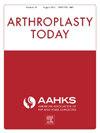Does a Provider Contact Wristband Reduce Emergency Department Visit Rates Following Hip or Knee Arthroplasty?
IF 1.5
Q3 ORTHOPEDICS
引用次数: 0
Abstract
Background
Reducing unnecessary emergency department (ED) visits following joint arthroplasty is an important goal. Literature suggests 30-day visit rates range between 4% and 15%, with only 20%-25% of these admitted for care. Low admissions suggest an opportunity to reduce unnecessary postarthroplasty ED visits. This study examined whether a wristband would encourage patients to call the care team with concerns prior to going to the ED.
Methods
A wristband displaying a contact phone number was placed on patients at discharge. ED visit rates (30 and 90 days) and readmissions (90 days) were tabulated for 2 years prior to and up to 3 years after the implementation of the wristband program. Residents who responded to calls and call logs were also reviewed.
Results
At 2 years after implementation, a total of 1023 joint replacements produced 273 calls or 1 call per 3.75 patients. Nearly half (48.1%) of the calls were received during weekday work hours when the patients had been directed to call the office. While ED visits declined after the implementation of the wristband at both 2 and 3 years, these reductions were not statistically significant (30 days: 5.1% before, 4.1% after; 90 days: 8.1% before, 7.1% after). There was a significant reduction in 90-day readmissions (6.4% before, 4.0% after).
Conclusions
Patients utilized the wristband number, but this did not significantly reduce the number of ED visits within 3 years. Future studies should track ED visits and identify decision-making factors behind ED use in order to find ways to improve the intervention.
医生联系腕带是否能降低髋关节或膝关节置换术后急诊室的就诊率?
背景:减少关节置换术后不必要的急诊科(ED)就诊是一个重要目标。文献显示,30天的住院率在4%到15%之间,其中只有20%到25%的人接受了治疗。低入院率表明有机会减少不必要的瓣后成形术急诊。这项研究调查了腕带是否会鼓励患者在去急诊室之前打电话给护理小组。方法:在出院时将显示联系电话号码的腕带放在患者身上。ED就诊率(30天和90天)和再入院率(90天)在腕带计划实施前2年和实施后3年被制成表格。对接听电话的居民和通话记录也进行了审查。结果:在实施后2年,总共1023例关节置换术产生273个电话或每3.75例患者1个电话。近一半(48.1%)的电话是在平日工作时间接到的,当时病人被指示打电话给办公室。虽然在佩戴腕带后的第2年和第3年,急诊科就诊人数都有所下降,但这些减少没有统计学意义(30天:佩戴腕带前5.1%,佩戴腕带后4.1%;90天:前8.1%,后7.1%)。90天再入院率显著降低(入院前6.4%,入院后4.0%)。结论:患者使用腕带数量,但这并没有显著减少3年内急诊科就诊次数。未来的研究应该跟踪ED就诊情况,确定ED使用背后的决策因素,以便找到改善干预措施的方法。
本文章由计算机程序翻译,如有差异,请以英文原文为准。
求助全文
约1分钟内获得全文
求助全文
来源期刊

Arthroplasty Today
Medicine-Surgery
CiteScore
2.90
自引率
0.00%
发文量
258
审稿时长
40 weeks
期刊介绍:
Arthroplasty Today is a companion journal to the Journal of Arthroplasty. The journal Arthroplasty Today brings together the clinical and scientific foundations for joint replacement of the hip and knee in an open-access, online format. Arthroplasty Today solicits manuscripts of the highest quality from all areas of scientific endeavor that relate to joint replacement or the treatment of its complications, including those dealing with patient outcomes, economic and policy issues, prosthetic design, biomechanics, biomaterials, and biologic response to arthroplasty. The journal focuses on case reports. It is the purpose of Arthroplasty Today to present material to practicing orthopaedic surgeons that will keep them abreast of developments in the field, prove useful in the care of patients, and aid in understanding the scientific foundation of this subspecialty area of joint replacement. The international members of the Editorial Board provide a worldwide perspective for the journal''s area of interest. Their participation ensures that each issue of Arthroplasty Today provides the reader with timely, peer-reviewed articles of the highest quality.
 求助内容:
求助内容: 应助结果提醒方式:
应助结果提醒方式:


